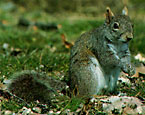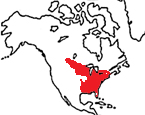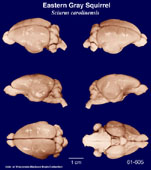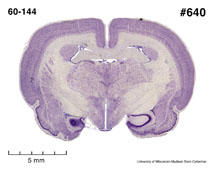|
Eastern Gray
Squirrel
(Sciurus carolinensis) #60-144 |
||||
|
|
Physical
characteristics and distribution
|
|
Head and body length of S. carolinensus is between 200-315
mm, tail length is 200-310 mm. Weights range from 200-1,000
grams. Upperparts are grey to greyish brown with paler, sometimes
whitish, underparts. There are two molts per year, but the tail
fur is only shed once each year. |
|
Description
of the brain
|
|
Animal
source and preparation
|
|
All
specimens collected followed the same preparation
and histological procedure.
|
Other Related Resources (websites and publications)
List of Specimens | Explore Collections | Brain Sections | Brain Evolution | Brain Development | Brain Circuitry | Brain Functions | Location and Use | Related Web Sites | Contact Us | Search MSU Database | Personnel | Home



